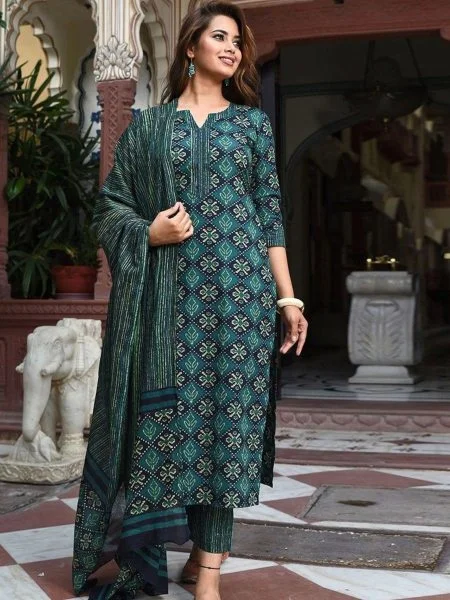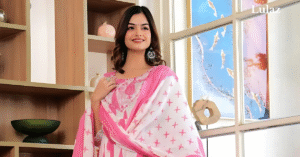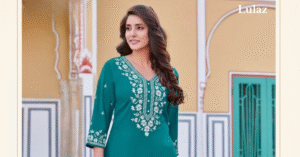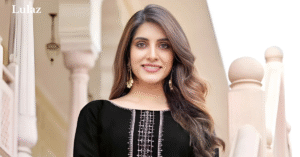Your Ultimate Guide to Seasonal Kurtas in Nepal
Throughout the year, the weather in Nepal is quite different from each other, including hot and humid summers, cold winters, and the season of plentiful rains, i.e., the monsoon season. Choosing the right clothing for each change of the year is not only a matter of style but also of comfort, breathability, and usefulness. Here is where the seasonal kurta in Nepal comes into play. The garments that can be used throughout the year will not only make you comfortable but also let you be a part of the colourful culture of fashion in Nepal.
If you are participating in the festival of Dashain or Tihar, or just strolling with friends and family in the busy streets of Thamel, or attending a traditional wedding in Lalitpur, then buying the right kurta for the season will be a great addition to the comfort and flair of your outfit. Depending on the time of year, seasonal kurtas are stocked with breathable cotton for summer, warm blends of silk and wool for winter, and lightweight water repellent gear for monsoon season, offering a range that is based on the local climatic conditions of Nepal.
Such a guide is necessary to acquaint you with some of the best summer, winter, or monsoon kurta options in Nepal, and also to help you with styling, selecting fabrics, and caring for your fashionable and practical wardrobe.

1) What is a Seasonal Kurta in Nepal?
Seasonal kurtas of Nepal represent a traditional kind of top that represents the seasons or the climate throughout the year. Although plain kurtas generally are for style, seasonal kurtas influence more on the breathability, weight, and moisture control.
- Summer kurtas come in bold colors and light materials for quick dry, cotton as a summer staple, or linen as the best pick, to feel fresh on hot and sticky days.
- Winter kurtas can be silks, wool blends, or cotton of different weights and multi-layers, to keep warm and stylish.
- Monsoon kurtas are made of fabrics such as rayon or georgette for quick dry and comfort during heavy rains, as well as to appreciate green and stay warm.
All of those kurtas are not only defined as traditional arts or crafts of Nepal, but are in fashion too, so you may be stylish at home, in the office, or professional event.
2) Why are Seasonal Kurtas Popular in Nepal?
The festivals, ceremonies, and social events that are part of Nepali life are the main reasons why kurtas have become the need of the day. Seasonal kurtas from Nepal are also very much in demand because of their versatility, as they can be worn for different occasions and are also very weather-friendly
i) Cultural Significance
The celebrations of festivals Dashain and Tihar generally consist of family meetings, pujas, and outdoor games. Keeping in view the hot temperature, wearing a pure cotton summer kurta in Nepal is considered very comforting and suitable for women during the hot months, so they can easily participate in the celebrations. While taking part in the cold-weather festivals, a winter kurta in Nepal is there to keep you warm.
ii) Weddings and Special Occasions
Traditional weddings are, most of the time, quite a long process; however, several hours of outdoor and indoor ceremonies are a major part of these weddings. The seasonal kurtas that are made from silk or georgette are ideal for layering with dupattas, jackets, or shawls. What these outfits do is they mingle beauty with utility, thus helping you stay comfortable at any point in the event.
iii) Modern Fashion Appeal
At present, the seasonal kurtas have moved a step further and are not only used as a part of tradition but also as a representation of lifestyle and fashion. Young professionals in Kathmandu and Pokhara often prefer cotton kurtas in summer for comfort and style, combining traditional charm with modern fashion sensibilities, which they smartly coordinate with office wear, getting the combination of comfort and contemporary styling just right. Monsoon-friendly fabrics like rayon or chiffon have become very popular and are mainly used for making casual outfits for rainy seasons.
iv) Everyday Wear
Seasonal kurtas have become the need of the day as these kurtas are being worn up to date, from casual walks in Patan Durbar Square to evening coffee dates in Thamel. Moreover, the option to mix and match with leggings, cigarette pants, palazzos, or skirts makes them not only a wardrobe staple for all seasons but also boosts their versatility.

3) Types and Styles of Seasonal Kurtas in Nepal
Kurtas from Nepal are available in many different cuts, fabrics, and styles that are appropriate for any time of year. Choosing the right fabric and silhouette will allow you to be comfortable and fashionable all year long.
i) Summer Kurtas in Nepal
- Fabrics: Lightweight fabrics such as cotton, linen, and rayon allow air circulation and keep you comfortable. Various comfortable fabrics help keep you cool in the summer heat.
- Style Tips: A loose-fitting shirt with short sleeves, or no sleeves, will help preserve airflow. Bright colors and floral prints serve a similar purpose with aesthetic value in summer.
- Popular Cuts: straight-cut, A-line, and high-low.
Pro Tip: For a stylish, effortless summertime look, wear lightweight leggings or palazzos with a kurta and minimal accessories.
ii) Winter Kurtas in Nepal
- Fabrics: silk blends, wool blend cotton, heavy rayon
- Style Tips: long sleeves, layered kurta from long to short sleeve styles, kurtas with shawls and jackets. Women often go with darker tones and complicated embroidery during winter festivities.
- Popular Cuts: Anarkali, layered A-line, and long straight-cut.
Pro Tip: wear a statement necklace and embroidered shawl with closed-toe shoes to complete your fashionable winter look.
iii) Monsoon Kurtas in Nepal
- Fabrics: georgette, chiffon, lightweight rayon
- Style Tips: Quick-drying fabrics will help you not get damp or uncomfortable while out in humid, rainy weather conditions. Knee-length kurtas or other shorter styles help to minimize puddle splashes.
- Popular Cuts: flared, straight cut with side slits, and longer high-low shape.
Pro Tip: Have some waterproof footwear with this fabric styling piece.
Explore a wide variety of fabrics, including cotton, linen, silk, georgette, and chiffon. You can also find seasonal guides like this blog on seasonal kurtas for more styling inspiration.
4) How to Style Seasonal Kurtas in Nepal?
How to fashion a kurta seasonally in Nepal basically means to get comfort, fabric, and context right. Here is a brief guide:
i) Accessories
- Summer: Subdued bling—stud earrings or light bangles
- Winter: Eye-catching pieces of jewelry such as necklaces, embroidered scarves, wool stoles
- Monsoon: Water-resistant watch, simple ear studs
ii) Footwear
- Summer: Sandals, kolhapuris, or flats
- Winter: Closed shoes, ankle boots, or traditional juttis
- Monsoon: Waterproof sandals or shoes
iii) Hairstyle
- Summer: Straightforward and easy ponytails or braids that keep the head cool
- Winter: Bun hairstyles or sleek buns
- Monsoon: Fast-drying buns or ponytails
iv) Event-Based styling
- Festivals: Embroidered dupattas, ethnic jewelry, and leggings will be perfect to match your kurta.
- Casual outings: Wear airy materials, not very much of a print, and comfortable shoes.
- Office wear: Select solid-colored straight-cut or cotton kurtas and team them up with palazzos or trousers.
Styling your kurta during winter, summer, and monsoon can be a challenge, and learning how to style kurtas can help a lot!

5) Where to Buy Seasonal Kurtas in Nepal?
Online store
Lulaz Wear offers a premium range of seasonal kurtas in Nepal that cater to every style and occasion. Visit Lulaz Wear Kurtas Collection for curated summer, winter, and monsoon kurtas crafted from high-quality fabrics.
Offline store
For offline shopping, Kathmandu and Pokhara host vibrant markets where traditional and contemporary kurtas are available: Asan Bazaar (Kathmandu): Known for cotton kurtas and daily wear essentials. New Road & Durbar Marg: Trendy boutiques with office-ready and festive kurtas. Pokhara Lakeside: casual kurta perfect for everyday wear
6) Care & Maintenance Tips
In order to keep your seasonal kurtas from fading and lasting, they must be looked after properly.
- Washing: Kurtas meant for summer (cotton, linen) are machine washable, which is okay in a gentle cycle. Kurtas for the winter (silk, wool blends) should either be hand-washed or dry-cleaned. Kurtas in the time of Monsoon (georgette, rayon) should be washed quickly and air dried so that there won’t be any mildew.
- Ironing: Should be kept at low to medium heat for delicate fabric. Iron inside out to protect print and/or embellishment
- Storage: Kurtas should be stored in breathable garment bags for storage to prevent moisture exposure and damage to the garment. Heavier kurtas for the wintertime should be folded properly so that there is no stretching of the fabric.
Pro Tip: If you can rotate your kurtas seasonally and mix by fabric type, it will help with longevity and colors staying crisp.
For a curated collection of the best kurta, explore Lulaz Wear’s kurta collection today

Frequently Asked Questions (FAQs)
What is a seasonal kurta in Nepal?
A seasonal kurta in Nepal is a traditional top designed with fabrics and styles suited to different weather conditions.
Which fabrics are best for a summer kurta in Nepal?
Cotton, linen, and lightweight rayon are ideal for summer kurtas in Nepal because they are breathable and comfortable in hot weather.
How should I style a winter kurta in Nepal?
To style the kurta, pair your winter kurta with layered shawls, jackets, and closed footwear. Accessories like statement necklaces enhance the festive appeal.
Where can I buy seasonal kurtas in Nepal?
You can check out Lulazwear as it offers a curated collection of kurtas for every season.
How do I choose the right kurta for each season in Nepal?
Choose fabrics and styles based on the weather: lightweight cotton or linen for summer, silk or wool blends for winter, and quick-drying rayon or georgette for monsoon
Conclusion
In Nepal, a seasonal kurta is not merely an article of clothing, but a fusion of culture, practicality, and current fashion. With summer cottons for hot weather, layers of silk fabric for colder climates, and water-friendly fabrics for monsoon rain, seasonal kurtas are practical, elegant garments.
See the perfect seasonal kurta looks for every Nepali festival and outing—check out our YouTube channel



